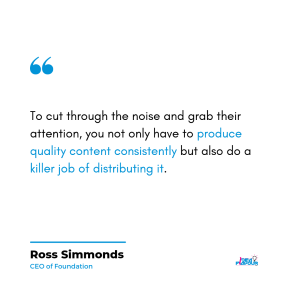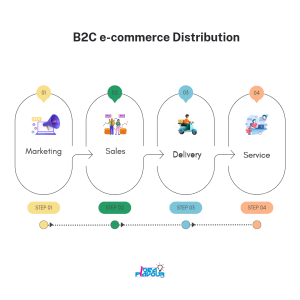We’re seeing a spike in eCommerce sales that’ll exceed $6 billion in 2024. How do you plan to cut a share of the cake?
No matter how narrow your business-to-consumer (B2C) eCommerce niche appears, how efficiently your distribution strategies are done will impact your returns.
We explored various models and handpicked the best B2C eCommerce distribution strategies, B2C distribution channels, and B2C marketing campaigns to amplify your brand’s voice amid the noise in your industry.
How the Right B2C Business Model in eCommerce Looks
Breakthrough in any successful B2C business is rooted in consumer satisfaction. Hence, a comprehensive understanding of your consumer‘s purchasing habits should inspire your marketing strategies.
Do they enjoy a seamless shopping experience with your product?
How quick is delivery?
Does your company provide an excellent return order policy?
Each idea, innovation, or strategy implemented in B2C e-commerce should gear at improving customer experience.
Answering these key questions helps you determine a precise model:
- What features make your product so peculiar?
- How does the competition target its audience?
- What makes your product the better option for your buyer persona?
This outlines some components to determine the right model and their corresponding descriptions:
| Component | Description |
| Vision | The overall goal you want to achieve in the future. |
| Objectives | Milestones to achieve your goal. |
| Customer target & challenges | Description of your target customers and their pain points. |
| Solution | How your product solves the pain points of your target users |
| Value | Functionality and unique edge over competitors |
| Pricing | The right cost for your solution amidst market factors. |
| Market | Channels to acquire your consumers |
| Growth | Strategies to grow your business |
B2C Sales Strategy Examples – Successful Distribution Case Studies to Model and How to Model Them
Listed below are four successful distribution case studies from leading companies and how to model them:
Adopting A Customer-Centric Strategy – Amazon
Amazon leads the B2C e-commerce marketplace with over 300 million active consumer accounts.
They use customer data to suggest products personalized to each consumer’s taste. This is because consumers are more likely to buy when the products are tailored to their needs.
Jeff Bezos shared the major contributor to Amazon’s success amidst other eCommerce marketplaces:
“…everything we’ve done and every success we have has its root primarily because we put customers first.”
Consider investing in a personalized recommendation engine that suggests products to customers based on their preferences and browsing history.
Conduct in-depth research to understand your customers. Use this data to inform other marketing strategies to increase customer engagement and loyalty.
Partnering With Influencers – Nike
Over the years, Nike has invested millions in partnering with major sports celebrities with a large following – C. Ronaldo, Drake, Lebron James, and many others. They believe these celebrities influence the purchasing powers of their end-users, which is true.
Nike offered M. Jordan a contract more attractive than other sports brands. They designed the Nike Jordan in white, red, and black to make it stand out from other players wearing plain white sneakers. This resulted in $126 million in revenue in the first year, 42X their initial expectations!
Partnering with the right influencer with similar goals can snowball your business MRR. However, you don’t have to find an A-list celebrity to get started.
Some micro-influencers charge money for partnerships, and others, a form of compensation like full access to your service. Consider identifying key influencers in your industry with a sizable audience.
Depending on the level of success generated from the initial campaign, increase your influencer marketing budget accordingly.
Making It Easy – Dollar Shave Club
Shave time. Shave Money.
This is the marketing mission of the Dollar Shave Club. Their first YouTube ad had over 28 million views and 12,000 signups in 28 hours. Of course, they did something right: making purchases seamless.
Dollar shave club is a subscription-based model service that offers customers a wide range of shaving products. Who wouldn’t opt for a quality razor delivered to your doorstep (removing the hassle of visiting a nearby store) for $1 a month?
Moreover, Dollar shave club competitor, Gizzete, was selling for $20, meaning customers get to save $19 at their convenience. The campaign generated over $50 million in sales in the first year.
Quality advertising, great products, excellent branding, and making purchases easy for your consumers are great ways to dominate the market.

Identify a Unique Value Proposition that’ll distinguish your brand from the competition. Dollar Shave Club, for example, uses the subscription-based model, a terrific way to gain customer loyalty for physical products.
Content Marketing b2C Strategy and Examples – QMR and FazWaz
Dansk Erhverv – Digital Handel’s latest statistical report on e-commerce in Denmark found that almost all consumers do product research before buying.
People rarely buy on a whim. When they do, a lot has gone into that single buying decision. Why did the user buy that item? Why did they choose that brand?
- Brand awareness
- Recommendations
- Brand Impressions
When you distribute relatable high-quality content around your products on various online distribution channels where your customers hang around, they find it helpful. That way, you’re building trust.
Your audience becomes aware of your brand and is likelier to engage with a call-to-action on your lead magnet.
Remember! No one reads or watches anything boring, so ensure your content is garnished with creativity. There are different content forms you can create:
- Blog posts
- Podcasts
- Videos for YouTube
- Short videos for social media
- Infographics
- Ebooks
- Social media posts
Before deciding on a content marketing strategy, audit your brand and the competition, point out what types of content your target audience spends time on online on whichever platform, and then map out short-term vs. long-term ranking targets.
After everything, review your strategy’s performance and re-strategize for better results.

QMR is a software company that caters to the financial industry. Their primary customer acquisition strategy is creating valuable and free content for customers. After the first eight months, they started generating more visibility on search engines.
We write approximately two highly-curated articles per week. We have a full-time writer in close contact with our team of researchers to ensure all information is relevant, precise, and robust.” CEO of QMR.ai, Martin Mayer-Krebs, says, “…our new content is ranking on search engines. Thanks to that, we shifted all our customer acquisition budget to creating content and reduced spending to a minimum.”
Fazwaz, one of Thailand’s largest real estate marketplaces, is also experiencing a surge in brand visibility after investing in creating quality content and effective marketing strategies.
They found what worked for them – content marketing – and stuck to it. It’s no wonder they’re a top choice online and offline.
With content marketing, we got mentions, shares, comments, and links which boosted our business to be an expert. You can gain the trust of other people in your business with this,” says Chanvit Khanijoun of FazWaz
If you’re wondering if content marketing still works for B2C eCommerce, qmr.ai and FazWaz are excellent proof. Plus, there’s no better time to start than now.
Point: Content marketing isn’t effective if done without a workable marketing strategy. Don’t focus on creating content alone. Choose marketing channel(s) that’ll get your messages seen and compel customers to respond.
Read also: 3 Top B2B eCommerce companies: Their Models and Marketing Strategies
Top 3 Powerful B2C Channels of Distribution

Each B2C distribution channel listed below applies to all b2c e-commerce products, whether physical or digital.
Direct Sales Distribution Strategy
Direct involves selling directly to consumers via your company’s e-commerce website. All activities are handled in-house, from production to delivery. The company also bears the costs incurred for marketing and advertising.
Although a direct sales distribution strategy might not be the fastest way to generate sales, it has several advantages that make it profitable.
Businesses can relate directly with consumers, understand their preferences, and adjust accordingly. They can also set and maintain quality control when producing and delivering customer goods and services.
In-direct Distribution Strategy
Businesses employ third-parties services, like wholesalers, retailers, or affiliates, to distribute the product in the indirect strategy.
The goal remains the same: ensuring customers get their products when needed. For instance, Nike lists their shoes on marketplaces like Amazon and Zappos. Here are the types:
Marketplaces
Marketplaces are third-party sites that connect buyers and sellers. Etsy is an example of a marketplace. Businesses looking to cut operational and marketing costs can list their products on marketplaces.
It removes the hassles of running your own store and provides better analytics into your customer purchase habit.
However, listing on marketplaces has a few challenges you can address. You have no control over the platform. You’re also likely competing with enough brands selling similar products or services.
eRetailers and Affiliate Marketing
Third-party eRetailers help you distribute. Usually, affiliates have a sizable audience that trusts their recommendations. Leveraging affiliate marketing increases brand visibility for your business and overall revenue generated.
Hybrid Distribution Strategy
The hybrid distribution strategy combines direct and indirect distribution models to reach customers. For instance, the manufacturer handles the production, while a third party delivers the product to the customers.
Or, the brand creates the service but uses a third-party payment system to collect payments from the end users.
B2c Ecommerce Examples
B2C e-commerce is a large growing industry with several models to differentiate them. Listed below are the main b2c e-commerce business models and examples of companies for each:
Direct Sales
This is the commonest type of b2c e-commerce business model. It involves selling directly to customers on a website or third-party marketplace. For instance, Zara and Amazon are direct sellers.
Subscription-based model
In this model, the brands offer services to customers at a periodic fee. This could be annually or monthly, or even both. Spotify and Netflix are popular subscription-based b2c e-commerce models.
Advertisement-based model
Here, sites with large audiences or viewers sell a portion of their space to brands that want to advertise directly to a specific audience. Popular examples of concerned platforms include YouTube, Reddit, Huffington Post, etc.
Community-based Model
Brands target online forums or communities with a similar audience to promote. Quora, Reddit, and Facebook groups are famous examples of these groups. Amazon Mechanical Turk is a perfect example of this business model.
Online Intermediaries
These sites act as middlemen, bringing businesses and customers together in one place. Here, brands can list their products for customers to find them. Examples are Etsy, Amazon, Walmart, etc.
2 Best B2C Marketing Campaigns
After studying over twenty marketing strategies from top brands, Spotify and Fenty stood out because of their consistent marketing success. See how they did it:
Customer-centric Marketing Strategy – Spotify
Founded less than two decades ago, Spotify has become one of the largest online streaming platforms, with almost 500 million active users. That’s more than the entire population of the United States! How?
Spotify adopts a customer-obsessed approach in all its marketing strategies. The Spotify Yearly Wrapped campaign is a good instance. The campaign exposes users to a compilation of their listening preferences on Spotify for the year and enables them to share on social media.
The results? A surge in app downloads every year!
Point: Adopt a data storytelling strategy into your marketing strategy to help users understand their preferences when using your products or service.
Inclusive Marketing – Fenty Beauty
In 2017, a month after Rihanna launched the Fenty beauty line, over 130 million fans rushed to watch the launch video, making it the largest launch of a make-up brand in the history of YouTube.
Although all-time-star Rihanna contributed to the success of Fenty, adopting inclusive marketing also played a significant role in the brand’s online success.
As highlighted by Fenty’s marketing director, Sandy Sapito, the goal for the brand has been clearly outlined since day one.
“From the beginning, our founder, Rihanna, made it very clear that no one should be excluded. So her vision – Beauty for All– became our marketing mission.”
With this singular mission in view, they launched a beauty brand that conveys a very striking and relatable message for women of all cultures. This made them feel comfortable, thought-of, unique, and truly inclusive.
Point: Understand your customers and listen to what’s most important to them. Craft your message to solve their problems regardless of the stage they’re in the marketing funnel.
Conclusion
Adopting a customer-first approach is the heart of any successful b2c eCommerce distribution strategy. As consumer habits evolve, leveraging emerging trends like Artificial Intelligence and Machine Learning impacts returns.
Carefully assess each of your distribution channels. Streamline logistics and order fulfillment, then set up qualitative order return regulations. With these, any b2c e-commerce brand can improve annual revenue and drive customer loyalty.
